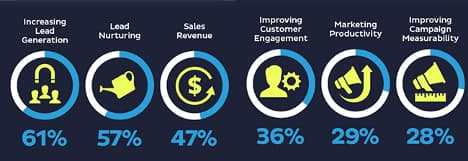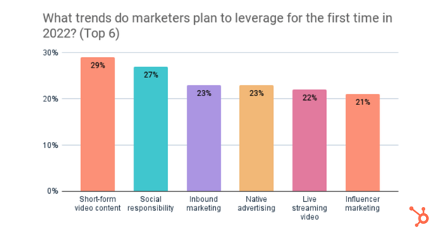Successful startups need more than just a great product or service idea and some assured funding. To identify, engage with, and satisfy consumers in today’s market, fledgling enterprises need to gather data on the target audience for their offerings and develop digital marketing strategies appropriate to creating brand awareness, customer acquisition, and the enhancement of the customer experience throughout the buyer’s journey.
Effective marketing in the digital economy is a time-consuming and complex process, involving many separate tasks. These marketing activities range from information collection and big data analysis, through monitoring website traffic and search engines, to the creation of relevant content and landing pages that can generate leads, influence purchase decisions, and ultimately satisfy the key metrics and business goals of the organisation.
A fully optimised campaign can boost the efficiency of your marketing efforts, strengthen your relationships with consumers, increase revenue, and help build your startup into a stable and profitable business. That's where marketing automation software comes into play.
Marketing automation can be instrumental in this optimisation, by taking mundane tasks out of the hands of your marketing professionals, leaving them free to concentrate on higher value activities.
The 5 Secrets of Successful Marketing Automation
To make automation an integral part of your startup marketing strategy, you'll need to invest in the necessary technology – that is, a marketing automation tool or solution. As with most business technology systems, there's a considerable choice, and not all marketing automation tools were created equal.
We'll look at some of the criteria for selecting the best marketing automation tools or platforms in a moment.
First, we’ll consider five moves you can make within your own organisation and its existing technology stack to make that automation solution work more effectively for your startup.
1. Optimise Your Customer Relationship Management (CRM) System
You should go through your existing CRM database to identify and delete any duplicate records, verify the names of all your contacts, and make sure that those contacts are associated with their correct accounts. Clean data is essential to an effective, segmented marketing approach for your marketing campaigns.
2. Verify All Email Addresses
Email marketing is a critical aspect of customer engagement, and contact information is an important part of market research. To ensure that this data remains accurate, you should run all email addresses through a verification service to identify those that are still active and flag any that are inaccurate.
3. Get Buy-In from Your Stakeholders, and Manage Changes
Your IT personnel, CRM administrators, creative, and marketing teams will all have a role to play in integrating existing systems with the best marketing automation platform available, and performing tasks such as contact verification. They will also create content, and take a hand in implementing your marketing strategies – so it's important to keep them all on board.
Marketing automation will also change the way that certain parts of the marketing process are performed, so it’s vital to explain these alterations, and prepare your workers before the system goes fully online.
4. Analyse, Test, and Update
The success of an automated marketing campaign should be measurable in terms of key metrics and performance indicators (rather than deceptive vanity metrics), which you should define early on and keep track of. By continually testing and analysing the results of your marketing plan, you can make updates to your automation settings as necessary, and create improved strategies.
5. Keep Learning
Over time, new marketing automation tools may become available, and new techniques may develop. So it’s important to keep up to date with industry intelligence, technology upgrades, and best practices.
Choosing Your Marketing Automation Platform
Regarding the marketing automation platform itself, here’s a checklist of criteria to consider when making your technology choice:
- Look for a solution with an intuitive interface, and ease of use
- Make sure it has a centralised data platform.
- Look for a system with tools for setting up a lead scoring framework, and fine-tuning customer segmentation.
- Use a solution with real-time analytics and reporting.
How to Create a Marketing Automation Strategy
Besides enabling you to generate real-time sales alerts, track visitors to your own online resources, and identify the websites that they visit, marketing automation can streamline the marketing process and assist in the creation of personalised content. It can also increase customer lifetime value (CLV) by automating customer follow-up activities, cross-selling, and up-selling.
In order to create a marketing automation strategy, you should:
- First, identify which processes that you wish to automate.
- Use SMART (Specific, Measurable, Attainable, Relevant, and Timely) goals to focus on business-critical objectives, provide a sense of direction, and help to organise your efforts.
- Create detailed documents identifying who your target buyers are.
- Develop a content marketing strategy to generate leads.
- Create clear, informative, and compelling content – whether it be a blog post, social media, or landing page.
- Distribute your content through several avenues, including non-search channels such as social media marketing and email.
- Devote a portion of your marketing budget to running ads for short-term results.
- Use a digital PR strategy to increase brand awareness.
- Measure and improve customer lifetime value (CLV), by tracking customer satisfaction and enhancing the customer experience.
- Ask for feedback, testimonials, referrals, and user-generated content to enhance your reputation.
This information will help you assess and choose the right marketing automation solution for your marketing activities.
How to Build an Effective Lead Generation Strategy Using Marketing Automation
Through lead generation, you can find prospective customers for your startup business and start turning them into paying consumers. You can do this by producing value-led content that provides genuinely useful advice, and by providing favourable offers or deals that ultimately lead your prospects to making a purchase.
In fact, according to a recent study by Invespcro, lead generation is the top goal of marketing automation, with the goal of generating better qualified leads in the shortest amount of time possible.

(Image source: Invespcro)

(Image source: HubSpot)
To use marketing automation effectively for lead generation you can:
- Optimise your website and landing pages, with a clear Call To Action (CTA) or next step for visitors to take – and an incentive for them to leave their contact details, such as a free download or trial.
- Position yourself on a par with other industry experts by using blogs, guest blogs, and other content as a showcase for your expertise.
- Segment your leads and serve them dynamic and personalised content based on their characteristics.
- Use retargeting to reach out to consumers who previously expressed interest in a product or service, but have yet to follow through on its purchase.
- Use drip campaigns and transactional emails to spur contacts to further action based on their personal characteristics and event-based triggers.
- Use conversational technology like Artificial Intelligence (AI) powered chatbots to provide 24/7 customer support, instantaneous responses on websites and social media, or answers to Frequently Asked Questions.
Building a Successful Automated Startup Marketing Strategy for Your Startup
Here are 5 steps to successful marketing automation for startups:
- Take a data-centric approach. Collect as much information about your customers as possible. Use analytics to assist in segmenting your consumers, and in crafting personalised content.
- Analyse your buyer’s journey. Identify the stages where automated work flows are most needed.
- Use targeted communications. You can micro-segment your target audiences to identify their specific needs.
- Make strategic use of your channels. Choose the most appropriate avenue for every outreach. Don’t overload your consumers by messaging them from every platform.
- Hyper-personalise. Make your content unique for every user, based on their individual characteristics.
Conclusion
Most start-ups can gain in both efficiency and focus with their marketing activity, by using the power of the right marketing automation software.
To learn more about how Incisive Edge can assist in successful marketing automation for your startup business, get in touch with us.








